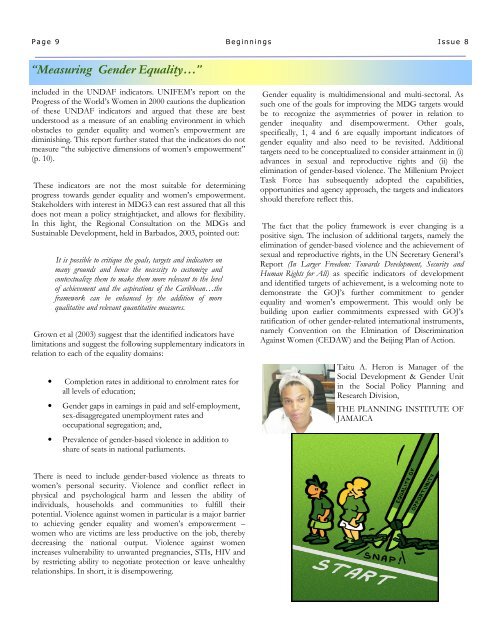Beginnings Issue 8.pub - Planning Institute of Jamaica
Beginnings Issue 8.pub - Planning Institute of Jamaica
Beginnings Issue 8.pub - Planning Institute of Jamaica
You also want an ePaper? Increase the reach of your titles
YUMPU automatically turns print PDFs into web optimized ePapers that Google loves.
P a g e 9 B eginnings I s s u e 8<br />
“Measuring Gender Equality…”<br />
included in the UNDAF indicators. UNIFEM’s report on the<br />
Progress <strong>of</strong> the World’s Women in 2000 cautions the duplication<br />
<strong>of</strong> these UNDAF indicators and argued that these are best<br />
understood as a measure <strong>of</strong> an enabling environment in which<br />
obstacles to gender equality and women’s empowerment are<br />
diminishing. This report further stated that the indicators do not<br />
measure “the subjective dimensions <strong>of</strong> women’s empowerment”<br />
(p. 10).<br />
These indicators are not the most suitable for determining<br />
progress towards gender equality and women’s empowerment.<br />
Stakeholders with interest in MDG3 can rest assured that all this<br />
does not mean a policy straightjacket, and allows for flexibility.<br />
In this light, the Regional Consultation on the MDGs and<br />
Sustainable Development, held in Barbados, 2003, pointed out:<br />
It is possible to critique the goals, targets and indicators on<br />
many grounds and hence the necessity to customize and<br />
contextualize them to make them more relevant to the level<br />
<strong>of</strong> achievement and the aspirations <strong>of</strong> the Caribbean…the<br />
framework can be enhanced by the addition <strong>of</strong> more<br />
qualitative and relevant quantitative measures.<br />
Grown et al (2003) suggest that the identified indicators have<br />
limitations and suggest the following supplementary indicators in<br />
relation to each <strong>of</strong> the equality domains:<br />
• Completion rates in additional to enrolment rates for<br />
all levels <strong>of</strong> education;<br />
• Gender gaps in earnings in paid and self-employment,<br />
sex-disaggregated unemployment rates and<br />
occupational segregation; and,<br />
• Prevalence <strong>of</strong> gender-based violence in addition to<br />
share <strong>of</strong> seats in national parliaments.<br />
There is need to include gender-based violence as threats to<br />
women’s personal security. Violence and conflict reflect in<br />
physical and psychological harm and lessen the ability <strong>of</strong><br />
individuals, households and communities to fulfill their<br />
potential. Violence against women in particular is a major barrier<br />
to achieving gender equality and women’s empowerment –<br />
women who are victims are less productive on the job, thereby<br />
decreasing the national output. Violence against women<br />
increases vulnerability to unwanted pregnancies, STIs, HIV and<br />
by restricting ability to negotiate protection or leave unhealthy<br />
relationships. In short, it is disempowering.<br />
Gender equality is multidimensional and multi-sectoral. As<br />
such one <strong>of</strong> the goals for improving the MDG targets would<br />
be to recognize the asymmetries <strong>of</strong> power in relation to<br />
gender inequality and disempowerment. Other goals,<br />
specifically, 1, 4 and 6 are equally important indicators <strong>of</strong><br />
gender equality and also need to be revisited. Additional<br />
targets need to be conceptualized to consider attainment in (i)<br />
advances in sexual and reproductive rights and (ii) the<br />
elimination <strong>of</strong> gender-based violence. The Millenium Project<br />
Task Force has subsequently adopted the capabilities,<br />
opportunities and agency approach, the targets and indicators<br />
should therefore reflect this.<br />
The fact that the policy framework is ever changing is a<br />
positive sign. The inclusion <strong>of</strong> additional targets, namely the<br />
elimination <strong>of</strong> gender-based violence and the achievement <strong>of</strong><br />
sexual and reproductive rights, in the UN Secretary General’s<br />
Report (In Larger Freedom: Towards Development, Security and<br />
Human Rights for All) as specific indicators <strong>of</strong> development<br />
and identified targets <strong>of</strong> achievement, is a welcoming note to<br />
demonstrate the GOJ’s further commitment to gender<br />
equality and women’s empowerment. This would only be<br />
building upon earlier commitments expressed with GOJ’s<br />
ratification <strong>of</strong> other gender-related international instruments,<br />
namely Convention on the Elmination <strong>of</strong> Discrimination<br />
Against Women (CEDAW) and the Beijing Plan <strong>of</strong> Action.<br />
Taitu A. Heron is Manager <strong>of</strong> the<br />
Social Development & Gender Unit<br />
in the Social Policy <strong>Planning</strong> and<br />
Research Division,<br />
THE PLANNING INSTITUTE OF<br />
JAMAICA

















